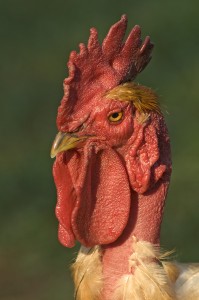Quick, what do you think of when I say “Transylvania”? Right. And where do vampires generally bite? Right again: on the neck. So, what are we to make of a breed of chicken called the Transylvanian Naked Neck? That is was bred to be bitten?

As for the original discussion, it ended with reference to a paper Prospects for conserving traditional poultry breeds of the Carpathian Basin in which the Transylvanian Naked Neck is just one of the breeds considered. There’s a bunch of stuff in there about why the breeds are valuable and how they’re being conserved, and lots of pictures. But not an answer to the fundamental question: What (if any) evolutionary value does a naked neck give its holder? Probably none. And if they suffer more in cold weather it could even be harmful, but at least some people, and not just photophobic immortals, find them attractive. Which is a good enough reason to conserve them. Luigi reckons they probably taste good too.
Photo by Flint-Hill, used with permission.
